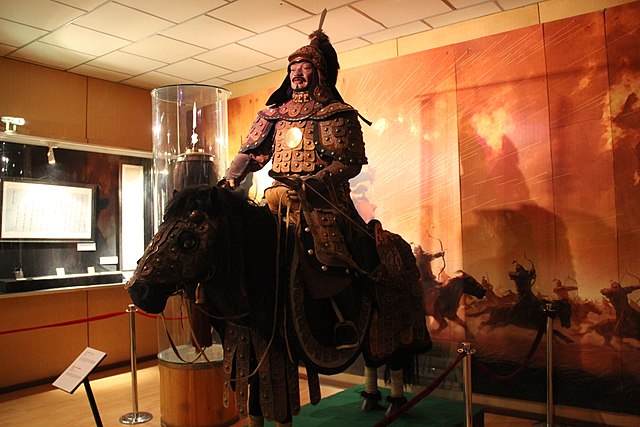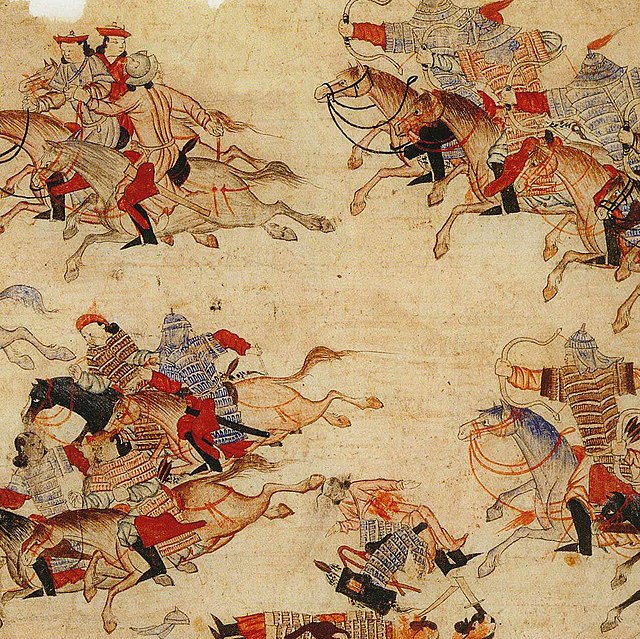Genghis Khan is one of history’s most renowned conquerors. After uniting the warring Mongol tribes in 1206 CE and establishing the Mongol Empire, Genghis Khan and his formidable cavalry set their sights on lands beyond Mongolia for conquest. His first targets were the Western Xia dynasty and Jin dynasty in Northern China.

Conquest of the Western Xia
The Western Xia dynasty controlled much of northwestern China in the early 13th century. Genghis Khan saw Western Xia as a threat, as it bordered his territory. Additionally, the ruler of Western Xia once supported Khan’s rivals, further straining relations between the two.
Khan began his campaign against Western Xia in 1209. His armies utilized superior mobility and adopted innovative strategies to defeat Western Xia’s defenses. For example, the Mongols diversionary tactics like false retreats to create confusion. Furthermore, they mastered the tactical use of smoke bombs to hide their maneuvers.
After several years of devastating raids and prolonged sieges, Western Xia finally surrendered in 1227. The Mongols annexed Western Xia territory, gaining control over the Gansu corridor and the Hexi Corridor - strategic trade routes along the Silk Road. This new territory provided a base to launch invasions deeper into China.

Conquering the Jin Dynasty
Emboldened by his victory over Western Xia, Genghis set aim on conquering lands of the Jin dynasty in northern China. The Jin dynasty was divided internally, with infighting existing between rival leaders. Sensing opportunity, Khan forged alliances with rebel Jin leaders to begin dismantling Jin territory piece by piece.
In 1211, the Mongols attacked the Jin stronghold at Zhongdu (modern day Beijing). The Jin military lacked mobile calvary and struggled against the swiftness of Mongol forces. After a year-long siege, Zhongdu fell, dealing a crippling blow to Jin leadership. This marked a turning point where Mongol forces took control over much of northern China.
Over the next fifteen years, the Mongols continued to subjugate Jin territories despite fierce resistance efforts. By 1234, the last Jin emperor committed suicide as Mongol forces finally crushed the dynasty completely. This ended over a century of Jurchen Jin rule over northern China.

Invasion into Central Asia
While campaigns were still ongoing against the Jin dynasty in eastern China, Genghis Khan also ordered expeditions west into Central Asia beginning around 1218. Khan sent forces to pursue fleeing Khwarezm Shahs, who once ruled an empire stretching across modern Iran and Turkmenistan. Upon catching up, the Mongols ravaged cities like Samarkand, Bukhara, and Urgench.
These victories opened the way for greater incursions across Central Asia. The Mongols invaded further, encountering little organized resistance from fragmented regional powers still recovering from the fall of Khwarezm Shah rule. This rapid expansion allowed the Mongols to annex territory in modern-day Uzbekistan, Kyrgyzstan, Tajikistan and Kazakhstan under their growing empire.
Control over Central Asia provided strategic benefits. It strengthened the Mongols grip over key trade hubs along the legendary Silk Road network. Additionally, it opened new mercantile connections between China and the Middle East. This allowed the Mongols to benefit tremendously from trade tariffs and tribute payments in the coming decades from their subject territories.

Impact on Surrounding Regions
News of Genghis Khan’s swift conquests shocked surrounding nations. Both Western Xia and the Jin dynasty once seemed strong regional powers, yet they crumbled before the Mongol onslaught. Neighboring Korean and Song Chinese rulers grew wary about this new rising steppe empire looming at their northern borders.
In the Middle East, the Abbasid Caliphate ruling modern-day Iraq sensed a grave threat as well. As Mongol forces neared their borders after taking Central Asia, the Abbasids struggled to mount defenses with drained resources. Genghis Khan’s conquests utterly changed the geopolitical landscape in only 20 short years. What once seemed a disunited band of nomads was now an emergent superpower altering the course of Asian history forever.
Why Were The Mongols So Successful Initially?
Many reasons explain why Genghis Khan achieved swift victories in his early conquests:
Military Innovation
The Mongols implemented tactical developments like surprise attacks, feigned retreats, and division of forces over widespread fronts. These innovated maneuvers confused and overwhelmed opponents.
Disciplined Cavalry
Mongol horsemen were highly organized in decimal units allowing complex battlefield orders over vast distances. Cavalry mobility also gave Genghis Khan an edge against more rigid infantry-based armies.
United Leadership
Genghis Khan ended tribal infighting and forged unity of purpose among once fractured Mongols clans. This tightened chain-of-command granted Mongol forces impressive coordination during invasions.
Weakness of Sedentary Societies
Targeted agrarian societies like Western Xia and Khwarezm proved fragile against the raids of the war-hardened nomadic Mongol lifestyle. Urbanized Jins also grew complacent as political infighting plagued its leadership.
Ambition
Khan possessed immense drive to expand Mongol power outward. Once proving dominance over steppe rivals, Khan proceeded to invade sedentary neighbors without hesitation or restraint.
These key ingredients catalyzed the early successes of Genghis Khan’s forces and struck fear into the hearts of rulers across Asia. It heralded the coming of a major empire that would soon stretch from eastern Europe to the Sea of Japan. The Mongol juggernaut was only just beginning.

Conclusion
In just over fifteen years, Genghis Khan utterly transformed the Mongols from a loose confederation of warring nomadic tribes into the dominant force in Asia. His disciplined cavalry and tactical prowess catalyzed the collapse of powerful neighbors including Western Xia, the Jin Dynasty, and Khwarezm Shah rule in Central Asia.
These conquests paralleled Alexander the Great’s expansion nearly a millennium earlier, but with arguably greater lasting impacts. Later Mongol leaders built upon Genghis Khan’s early victories to create the largest contiguous land empire in human history. Reverberations from Mongol invasions also profoundly shaped the modern sociopolitical structure of Asia and Eastern Europe for centuries to come.
Frequently Asked Questions
What were some of Genghis Khan’s first conquests?
Genghis Khan’s earliest conquests after uniting the Mongol tribes included invasions of the Western Xia and Jin dynasties in northern China. He also rapidly expanded west into Central Asia to fill the power vacuum left by the fallen Khwarezm Empire across modern-day Uzbekistan and Kazakhstan.
How did the Mongols defeat the Western Xia dynasty?
The Mongols won against Western Xia using their superior mobility and through innovated battle tactics to raid cities and lengthy sieges to gradually wear down Western Xia strongholds over several years. Western Xia ultimately surrendered in 1227 CE.
Why were the Mongols able to conquer the lands of the Jin dynasty?
The Mongols took advantage of political turmoil from factional infighting plaguing Jin leadership at the time. They also attracted rebel Jin factions as Mongol allies. Combined with cavalry strength against rigid Jin infantry, the Mongols managed to pick apart Jin territories region by region over 15 years.
How did the Mongols come to rule Central Asia so quickly?
Mongol pursuit of fleeing Khwarezm Shah princes allowed them to swarm into Central Asia against minimal resistance. The Mongols filled the regional power vacuum remaining after the fall of the Shahs and the splintering of their empire across modern Kazakhstan, Uzbekistan and beyond.
How did initial civilizations view Genghis Khan’s early victories?
Contemporary civilizations like the Song dynasty, Korea, and the Abbasid Caliphate grew extremely anxious witnessing the swiftness by which the once obscure Mongol tribes under Genghis Khan established hegemony over Northern China, Western Xia and Khwarezm lands. It signaled the rise of a threatening new superpower.
Sources
Britannica, The Editors of Encyclopaedia. “Jin Dynasty.” Encyclopedia Britannica, July 20, 1998. https://www.britannica.com/topic/Jin-dynasty-China-AD-265-316-317-317-420.
Man, John. “Genghis Khan.” Encyclopedia Britannica, September 23, 2022. https://www.britannica.com/biography/Genghis-Khan.
“Siege of Beijing.” Wikipedia, March 8, 2022. https://en.wikipedia.org/wiki/Siege_of_Beijing.
Weatherford, Jack. Genghis Khan and the Making of the Modern World. New York: Crown Publishers, 2004.